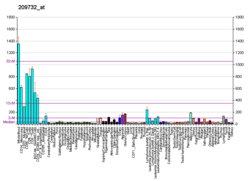C-type lectin domain family 2 member B is a protein that in humans is encoded by the CLEC2B gene.[3][4]
This gene encodes a member of the C-type lectin/C-type lectin-like domain (CTL/CTLD) superfamily. Members of this family share a common protein fold and have diverse functions, such as cell adhesion, cell-cell signalling, glycoprotein turnover, and roles in inflammation and immune response. The encoded type 2 transmembrane protein may function as a cell activation antigen. An alternative splice variant has been described but its full-length sequence has not been determined. This gene is closely linked to other CTL/CTLD superfamily members on chromosome 12p13 in the natural killer gene complex region.[4]
Further reading
- Drickamer K (1999). "C-type lectin-like domains". Curr. Opin. Struct. Biol. 9 (5): 585–90. doi:10.1016/S0959-440X(99)00009-3. PMID 10508765.
- Gerhard DS, Wagner L, Feingold EA, et al. (2004). "The status, quality, and expansion of the NIH full-length cDNA project: the Mammalian Gene Collection (MGC)". Genome Res. 14 (10B): 2121–7. doi:10.1101/gr.2596504. PMC 528928. PMID 15489334.
- Ebner S, Sharon N, Ben-Tal N (2003). "Evolutionary analysis reveals collective properties and specificity in the C-type lectin and lectin-like domain superfamily". Proteins. 53 (1): 44–55. doi:10.1002/prot.10440. PMID 12945048.
- Strausberg RL, Feingold EA, Grouse LH, et al. (2003). "Generation and initial analysis of more than 15,000 full-length human and mouse cDNA sequences". Proc. Natl. Acad. Sci. U.S.A. 99 (26): 16899–903. doi:10.1073/pnas.242603899. PMC 139241. PMID 12477932.
- Renedo M, Arce I, Montgomery K, et al. (2000). "A sequence-ready physical map of the region containing the human natural killer gene complex on chromosome 12p12.3-p13.2". Genomics. 65 (2): 129–36. doi:10.1006/geno.2000.6163. PMID 10783260.
- Yokoyama-Kobayashi M, Yamaguchi T, Sekine S, Kato S (1999). "Selection of cDNAs encoding putative type II membrane proteins on the cell surface from a human full-length cDNA bank". Gene. 228 (1–2): 161–7. doi:10.1016/S0378-1119(99)00004-9. PMID 10072769.
- Bonaldo MF, Lennon G, Soares MB (1997). "Normalization and subtraction: two approaches to facilitate gene discovery". Genome Res. 6 (9): 791–806. doi:10.1101/gr.6.9.791. PMID 8889548.


